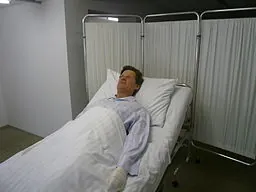Posterior Hip Dislocation
Posterior Hip Dislocation
I’m Ed Smith, a Modesto auto accident attorney. Most people know that auto accidents can cause traumatic injuries. One of the more regular and serious injuries is a posterior hip dislocation. While not a common injury overall, most posterior hip dislocations are caused by car accidents. This injury varies widely in severity because the head of the hip may or may not sever important structures when it comes out of place. Some of the important vulnerable structures include the arteries, veins, and nerves that supply the hip and lower leg. If these structures are compromised, this injury is a medical emergency.
Rear End Car Crashes
When one car rear ends another vehicle, the driver of the rear car may have the front of the car collapse. The collapse of the front of the car is designed to spread out the duration of the forces applied and reduce the chances that a sudden deceleration causes traumatic injury to the rest of the body. Unfortunately, the collapse of the front of the car can also cause significant injury to the legs because the legs are extended at the front of the car to work the pedals. When the front of the car collapses, the knees strike the dashboard and the legs are forced backwards with the front of the car. If the force is great enough, the head of the hip can dislocate out of the back of the socket. This can cause severe injury.
Symptoms of Posterior Hip Dislocation
Important symptoms in posterior hip dislocations include a swollen or painful hip that may appear obviously out of place. Most importantly, when the patient is laid flat the dislocated hip will cause the corresponding leg to appear shorter and internally rotated when compared to the other leg. While the appearance is usually all that is needed for a diagnosis, it can be easily confirmed with an x-ray.
Injuries to Other Structures
It is vitally important to assess injuries to other structures. When the femoral head pops out of place, the sciatic nerve can be damaged. This is the largest nerve in the body and supplies motor function and sensation to the leg and foot. If the patient cannot feel the back of the leg or move the foot, this is a sign of sciatic nerve injury. While injury to blood vessels is not as common with posterior hip dislocations as it is with anterior hip dislocations, these vascular structures should still be assessed.
Rapid Treatment to Preserve Leg Function
Rapid treatment is essential for preservation of leg function. The longer the hip is dislocated, the longer the femoral head is without a blood supply. A delay in treatment can cause avascular necrosis of the femoral head, which leads to bone death and will require surgery. After providing the patient with adequate anesthesia, the orthopedics team will reduce the dislocation and place the hip back into place. If avascular necrosis has occurred, a hip replacement is required. Long-term physical therapy is needed to restore hip and leg function. Strong hip muscles are required to prevent future dislocations. Once a bone has been dislocated once, it is easier to dislocate in the future.
Modesto Personal Injury and Auto Accident Attorney
Hi, I’m Ed Smith, a Modesto auto accident attorney. If you or someone close to you has suffered a serious injury in a car crash, please give me a call anytime at (209) 227-1931 or (800) 404-5400 for fast, free and friendly advice.
I’m honored to be a member of the California section of the Million Dollar Advocates Forum. Members listed in the forum are top trial lawyers in the United States with verdicts and settlements in the multiple-million dollar range.
Take a look at the past verdicts and settlement results obtained by my office.
The injury lawyers at the Edward A Smith Law Offices have been extensively reviewed on:
Yelp, Google and Avvo (the attorney rating platform).
Image Attribution: Wikimedia Commons
:DR

